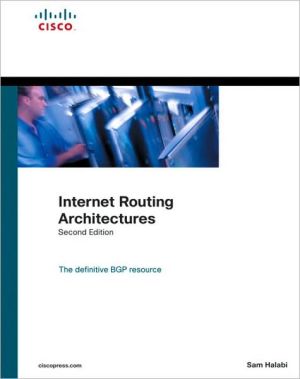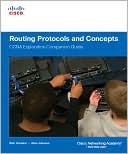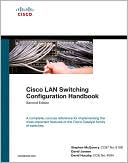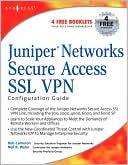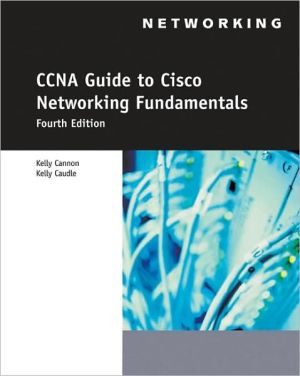Internet Routing Architectures
The industry's leading resource for Internet routing solutions and scenarios\ \ Explore the functions, attributes, and applications of BGP-4, the de facto interdomain routing protocol, through practical scenarios and configuration examples\ Learn the contemporary Internet structure and understand how to evaluate a service provider in dealing with routing and connectivity issues\ Master the addressing techniques--including Classless Interdomain Routing (CIDR)--that are demanded today to...
Search in google:
The industry's leading resource for Internet routing solutions and scenarios Explore the functions, attributes, and applications of BGP-4, the de facto interdomain routing protocol, through practical scenarios and configuration examples Learn the contemporary Internet structure and understand how to evaluate a service provider in dealing with routing and connectivity issues Master the addressing techniques—including Classless Interdomain Routing (CIDR)—that are demanded today to facilitate the Internet's rapid and continuing growth Develop optimal routing policies—redundancy, traffic balancing, symmetry, and stability—for your network Learn how to seamlessly integrate your intradomain and interdomain routing and manage large and growing autonomous systemsInternet Routing Architectures, Second Edition, explores the ins and outs of interdomain routing network designs with emphasis on BGP-4 (Border Gateway Protocol Version 4)—the de facto interdomain routing protocol.Using a practical, example-oriented approach, this comprehensive resource provides you with real solutions for ISP connectivity issues. You will learn how to integrate your network on the global Internet and discover how to build large-scale autonomous systems. You will also learn to control expansion of interior routing protocols using BGP-4, design sound and stable networks, configure the required policies using Cisco IOS Software, and explore routing practices and rules on the Internet.157870233X020206
\ \ Chapter 1: Evolution of the Internet\ The structure and makeup of the Internet has adapted as the needs of its community have changed. Today's Internet serves the largest and most diverse community of network users in the computing world. A brief chronology and summary of significant components are provided in this chapter to set the stage for understanding the challenges of interfacing the Internet and the steps involved in building scalable internetworks. \ Origins and Recent History of the Internet\ The Internet started as an experiment in the late 1960s by the Advanced Research Projects Agency (ARPA, now called DARPA) of the U.S. Department of Defense'. DARPA experimented with the connection of computer networks by giving grants to multiple universities and private companies to get them involved in the research. In December 1969, an experimental network went online with the connection of a fournode network connected via 56 kbps circuits. The new technology proved to be highly successful and led to the creation of two similar military networks-MILNET in the U.S. and MINET in Europe. Thousands of hosts and users subsequently connected their private networks (universities and government) to the ARPANET, thus creating the initial "ARPA Internet." Figures 1-1 and 1-2 illustrate the ARPANET in the early days, from its inception in 1969 to its growing number of connectors in 1976.\ The conglomeration of research, academic, and government networks, combined with the ARPANET core network, was the beginning of what came to be known as the Internet. However, ARPANET had an Acceptable Usage Policy (AUP) that prohibited the use of the Internet for commercial purposes. Nonetheless, the usefulness of the ARPANET to its connectors resulted in scalability problems, the most apparent of which was link congestion. As a result, the National Science Foundation (NSF) began development of the NSFNETZ.\ The ARPANET was decommissioned in 1989.\ From ARPANET to NSFNET\ By 1985, the ARPANET was heavily utilized and burdened with congestion. In response, the National Science Foundation initiated phase 1 development of the NSFNET. The NSFNET was composed of multiple regional networks and peer networks (such as the NASA Science Network) connected to a major backbone that constituted the core of the overall NSFNET.\ In its earliest form, in 1986, the NSFNET created a more distributed, three-tiered network architecture. This architecture connected campuses and research organizations to regional networks, which in turn connected to a main backbone network linking six nationally funded supercomputer centers. The original links of 56 kbps were upgraded in 1988 to faster T1 (1.544 Mbps) links. This was a result of the 1987 NSF competitive solicitation for faster network service, awarded to Merit Network, Inc. and its partners MCI, IBM, and the state of Michigan. The NSFNET T 1 backbone connected a total of 13 sites, including Merit, BARRNET, MidNet, Westnet, NorthWestNet, SESQUINET, SURAnet, NCAR (National Center for Atmospheric Research), and five NSF supercomputer centers.\ In 1990, Merit, IBM, and MCI started a new organization known as Advanced Network and Services (ANS). Merit's Internet engineering group provided a policy routing database and routing consultation and management services for the NSFNET, whereas ANS operated the backbone routers and a Network Operation Center (NOC). By 1991, data traffic had increased tremendously, which necessitated upgrading the NSFNET's backbone network service to T3 (45 Mbps) links. Figure 1-3 illustrates the original NSFNET with respect to the location of its core and regional backbones...
Pt. IThe Contemporary InternetCh. 1Evolution of the InternetCh. 2ISP Services and CharacteristicsCh. 3IP Addressing and Allocation TechniquesPt. IIRouting Protocol BasicsCh. 4Interdomain Routing BasicsCh. 5Border Gateway Protocol Version 4Pt. IIIEffective Internet Routing DesignsCh. 6Tuning BGP CapabilitiesCh. 7Redundancy, Symmetry, and Load BalancingCh. 8Controlling Routing Inside the Autonomous SystemCh. 9Controlling Large-Scale Autonomous SystemsCh. 10Designing Stable InternetsPt. IVInternet Routing Device ConfigurationCh. 11Configuring Basic BGP Functions and AttributesCh. 12Configuring Effective Internet Routing PoliciesApp. ABGP Command ReferenceApp. BReferences for Further StudyApp. CBGP Outbound Route Filter (ORF)App. DMultiprotocol BGP (MBGP)
\ From Barnes & NobleHere's an authoritative guide to stable, large-scale Internet routing with BGP-4: network design, Cisco IOS configuration, Classless Interdomain Routing (CIDR), redundancy, traffic balancing, symmetry, and more. This book gives you the information you evaluate the networks of competing Internet Service Providers, make intelligent Internet routing decisions, and implement them.\ \
